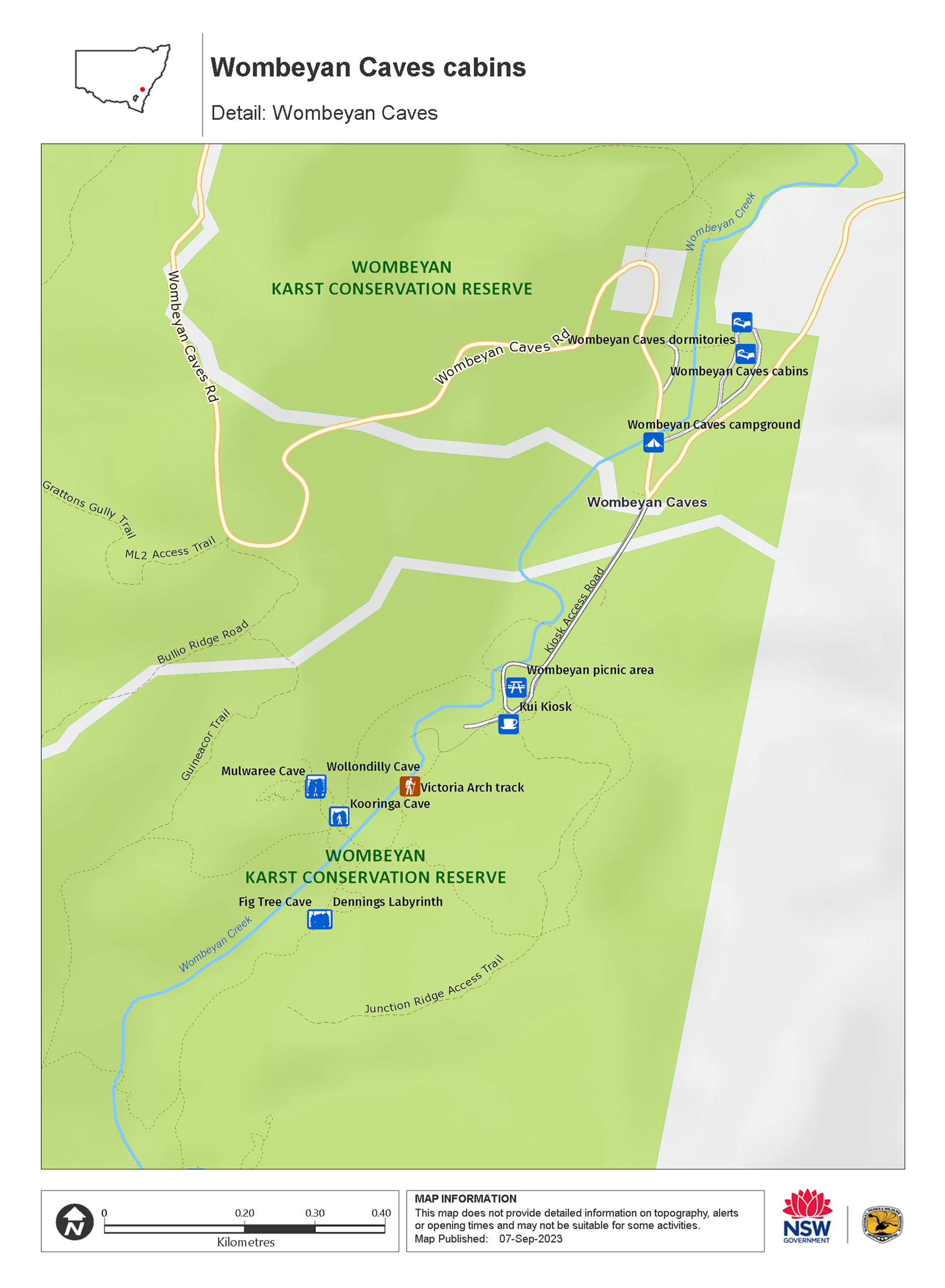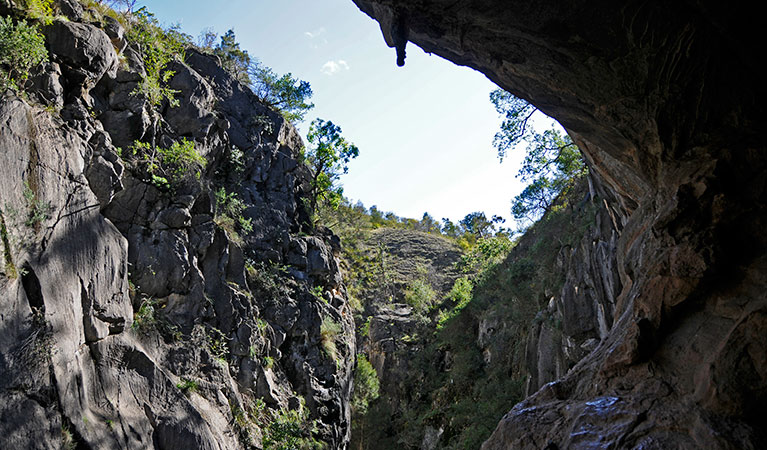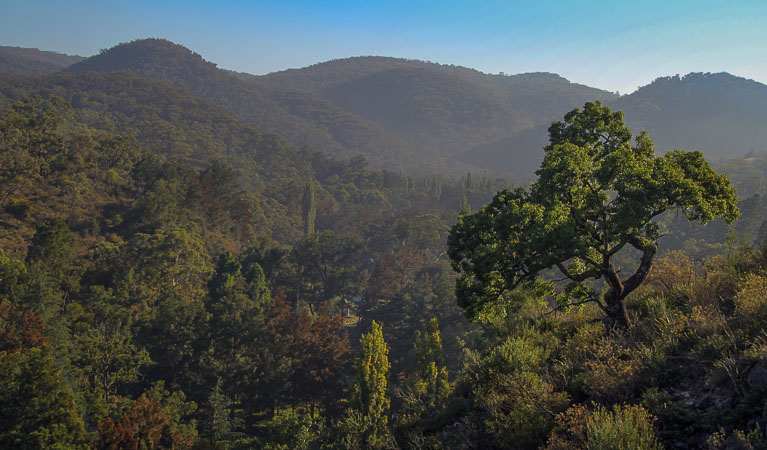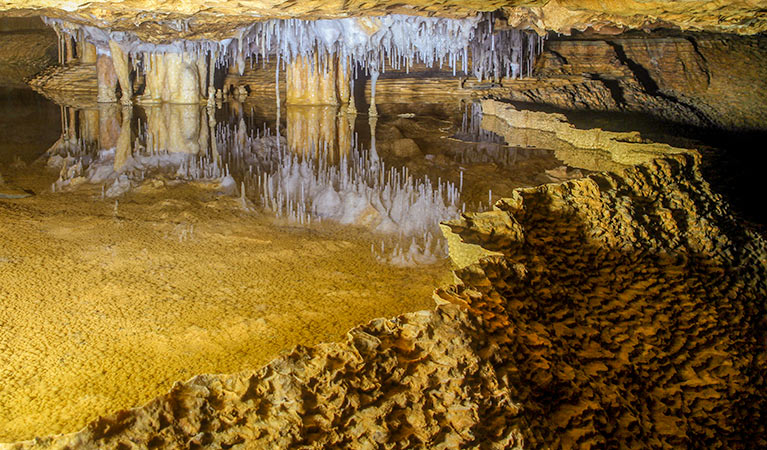Wombeyan Caves cabins
Wombeyan Karst Conservation Reserve
Overview
Explore the spectacular caves at Wombeyan Karst Conservation Reserve and stay in one of these self-contained cabins. It’s a great spot for a weekend break for families and couples.
| Accommodation type | Cabin |
|---|---|
| Where | 24 Wombeyan Caves Road, Wombeyan Caves, NSW, 2580 - in Wombeyan Karst Conservation Reserve |
| Bedrooms | 2 |
| Maximum guests | 6 |
| Facilities | Barbecue facilities, drinking water, public phone, showers, toilets, electric power, kitchen, plates and cutlery, pots and pans, heating, rubbish bin |
| What to bring | Bed sheets, blankets, pillows, pillow cases, towels, shampoo and soap |
| Please note |
|
Take advantage of this secluded little spot and book a weekend away in one of these cosy cabins. Wake up to the call of magpies and lyrebirds, before heading out to explore the Wombeyan Caves on a guided tour. When you return, put your feet up on the balcony and relax while the resident kangaroos and satin bowerbirds pass by.
This is a great place for some quality time out in nature, whether you're here with friends, your partner or the whole family. The cabins are self-contained with an outdoor barbecue area.
Map legend

Map

Local alerts
For the latest updates on fires, closures and other alerts in this area, see https://uat.nswparks.cloud/camping-and-accommodation/accommodation/wombeyan-caves-cabins/local-alerts
Bookings
- National Parks Contact Centre
- 7am to 7pm daily
- 1300 072 757 (13000 PARKS) for the cost of a local call within Australia excluding mobiles
- parks.info@environment.nsw.gov.au
Park info
- in Wombeyan Karst Conservation Reserve in the Country NSW region
Wombeyan Karst Conservation Reserve is always open but may have to close at times due to poor weather or fire danger.
Visitor info
All the practical information you need to know about Wombeyan Caves cabins.
Maps and downloads
Learn more
Wombeyan Caves cabins is in Wombeyan Karst Conservation Reserve. Here are just some of the reasons why this park is special:
Aboriginal connections

Wombeyan Karst Conservation Reserve is located within the traditional lands of the Gundungurra People, with the word Wombeyan coming from local language meaning 'Wombat' or 'home of the Wombat'. It's believed that Wombeyan Caves were part of an Aboriginal travel route, with the caves providing reliable shelter. The Dreamtime story of Gurangatch relates to the forming of Wombeyan and Jenolan caves. They are said to have been formed during a contest between 2 mythical beings, Gurangatch and Mirragang. Gurangatch was part fish and part reptile, and Mirragan was a legendary tiger cat.
Life in the air

Wombeyan Karst Conservation Reserve plays a special role in the conservation of some of Australia's precious native flora and fauna. The moist forest that surrounds the park's creeks is home to superb lyrebirds, eastern whipbirds and flycatchers – look for lyrebird scratches on the forest floor. Around the park's rocky outcrops, see if you can spy birds of prey, including brown goshawks and wedge tailed eagles. You'll have to look particularly carefully to see a tawny frogmouth. Their camouflage is excellent – they stay very still and upright, and you might mistake them as part of the branch they're perched on.
- Victoria Arch walking track Victoria Arch walking track is a short, accessible walk in Wombeyan Karst Conservation Reserve. The easy bushwalk takes you to a viewing platform overlooking a remarkable natural rock formation.
On show

The limestone in the caves of Wombeyan Karst Conservation Reserve is 430 million years old. The geological processes that have created the magnificent cave system you see today continue to work their magic. You'll notice the impressive cave decorations, including stalactites and stalagmites, that are created by the infiltration of water into the caves. Take a guided cave tour to find out more about the history and geology of the caves.
- Dennings Labyrinth Dennings Labyrinth in Wombeyan Karst Conservation Reserve is currently closed to the public. Visitors will be advised when the cave reopens for tours.
- Fig Tree Cave Be sure to take a family-friendly, self-guided tour through the impressive Fig Tree Cave while you’re at Wombeyan Karst Conservation Reserve. It’s widely regarded as one of NSW’s best self-guided cave experiences.
- Kooringa Cave The ornately decorated Kooringa Cave in Wombeyan Karst Conservation Reserve is sure to impress. Bring your camera to capture striking columns and rippled draperies on a guided tour through this single-chamber cave.
- Mulwaree Cave Join a 1hr guided tour through the magnificent Mulwaree Cave in Wombeyan Karst Conservation Reserve. Inside this cave you’ll see shining decorations, large stalactites and spectacular colour variations on the walls.
- Victoria Arch walking track Victoria Arch walking track is a short, accessible walk in Wombeyan Karst Conservation Reserve. The easy bushwalk takes you to a viewing platform overlooking a remarkable natural rock formation.
Plants and animals protected in this park
Animals
-

Eastern bentwing-bat (Miniopterus schreibersii oceanensis)
Eastern bentwing-bats congregate in caves across the east and north-west coasts of Australia, in colonies of up to 150,000. These small Australian animals weigh around 13-17g and can reach speeds of up to 50km per hour. Eastern bentwing-bats use both sight and echolocation to catch small insects mid-air.
-

Bare-nosed wombat (Vombatus ursinus)
A large, squat marsupial, the Australian bare-nosed wombat is a burrowing mammal found in coastal forests and mountain ranges across NSW and Victoria. The only other remaining species of wombat in NSW, the endangered southern hairy-nosed wombat, was considered extinct until relatively recently.
-

Common brushtail possum (Trichosurus vulpecula)
One of the most widespread of Australian tree-dwelling marsupials, the common brushtail possum is found across most of NSW in woodlands, rainforests and urban areas. With strong claws, a prehensile tail and opposable digits, these native Australian animals are well-adapted for life amongst the trees.
-

Common ringtail possum (Pseudocheirus peregrinus)
Commonly found in forests, woodlands and leafy gardens across eastern NSW, the Australian ringtail possum is a tree-dwelling marsupial. With a powerful tail perfectly adapted to grasp objects, it forages in trees for eucalypt leaves, flowers and fruit.

